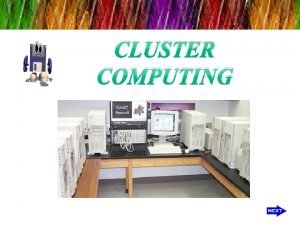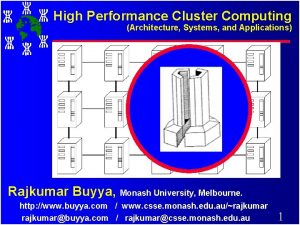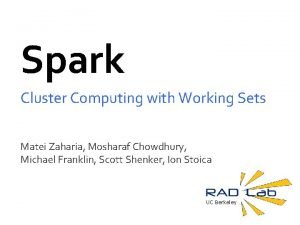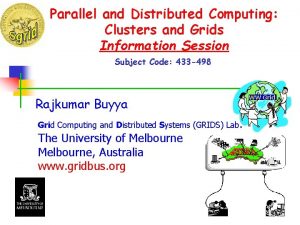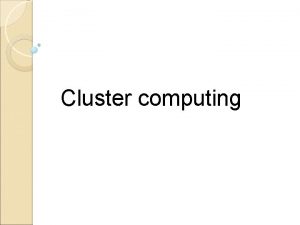CLUSTER COMPUTING INTRODUCTION Cluster is a widely used















- Slides: 15

CLUSTER COMPUTING

INTRODUCTION Cluster is a widely used term meaning independent computers combined into a unified system through software and networking Clusters are typically used for High Availability (HA) for greater reliability or High Performance Computing (HPC) to provide greater computational power than a single computer can provide. Clusters are composed of many commodity computers, linked together by a high-speed dedicated network

Cluster categorization • High-availability (HA) clusters • Load balancing clusters • High-performance (HPC) clusters • Grid Cluster

Cluster Architecture A cluster is a type of parallel or distributed processing system that consists of a collection of interconnected stand-alone computers working together as a single, integrated computing resource

Cluster Computing Features • • • Network technologies Network Types Communication Protocols Operating system Single System Image (SSI) Quorum

Production of High Throughput Cluster Computing Applications • Divide and Conquer • Data Management • Shared Storage Architectures

HOMER CLUSTER Used for e-mail and information resources Architecture A cluster is made up of six components • Compute servers • File servers • Password servers • Application servers • Mail servers • Reference systems

Hardware Topology :

Dell high performance computing combines multiple Symmetric Multi-Processor (SMP) computer systems together with high-speed interconnects to achieve the rawcomputing power of supercomputers HPCC Architecture

HPCC Building Block

BENEFITS • scale to very large systems • replacing a "bad machine" within a cluster is trivial yields much higher Availability LIMITATIONS • • • Typically latency is very high and bandwidth relatively low. Currently there is very little software support for treating a cluster as a single system. Problems exist in the interactions between mixed application workloads on a single timeshared computer APPLICATIONS • execution platform for a range of application classes • to execute many Internet applications • execution environments for applications such as weather modeling, automobile crash simulations, life sciences, computational fluid dynamics etc.

Comparing with other distributed computing Characteristic Cluster Grid P 2 P Resource Management (i. e. memory, objects, storage, network access, etc) Centralized Distributed Resource Ownership Singular (Often locked to a single node to prevent data corruption) Singular or multiple, varies from platform to platform Singular, multiple, or distributed, depending on circumstance and architecture Method of Resource Allocation / Scheduling Centralized, allocated according configuration Decentralized N/A, there is no single permanent host for centralized data or resource management. Everything is transient. External Representation Single Image Single or multiple image(s) Unknown, it is circumstantial Inter-Operability Guaranteed within a cluster Enforced within a framework Multiple competing standards Suggested Equipments Mostly high-end, high capability systems High-end or commodity systems Any type, including wireless device and embedded systems. Scaling 2 - 16 way (Although, theoretically 128+ is possible) Two to thousands units connection Theoretically, infinite (In actuality, it depends on network backbone transmission speed, number of clients, and type of transmission protocol…. . ) Discovery Mechanism Defined membership (Static or Dynamic) Centralized index, as well as, multiple decentralized mechanisms. Always decentralized discovery mechanism.

CONCLUSION Cluster computing has become a major part of many research programs because the price to performance ratio of commodity clusters is very good. Also, because the nodes in a cluster are clones, there is no single point of failure, which enhances the reliability to the cluster.

THANK Q

 What is biomedical therapy
What is biomedical therapy Types of sheet metal joints ppt
Types of sheet metal joints ppt The most widely used agile process, originally proposed by
The most widely used agile process, originally proposed by What is the sequence of installation on rhipe
What is the sequence of installation on rhipe Types of distillation
Types of distillation Initial permutation in des calculator
Initial permutation in des calculator Cluster computing meaning
Cluster computing meaning Most widely practiced religion
Most widely practiced religion Most widely practiced religion
Most widely practiced religion Why is popular culture widely distributed
Why is popular culture widely distributed Religion of africa
Religion of africa Cluster computing architecture
Cluster computing architecture Cluster computing definition
Cluster computing definition Spark: cluster computing with working sets
Spark: cluster computing with working sets Cluster in parallel and distributed computing
Cluster in parallel and distributed computing Shared computing cluster
Shared computing cluster






